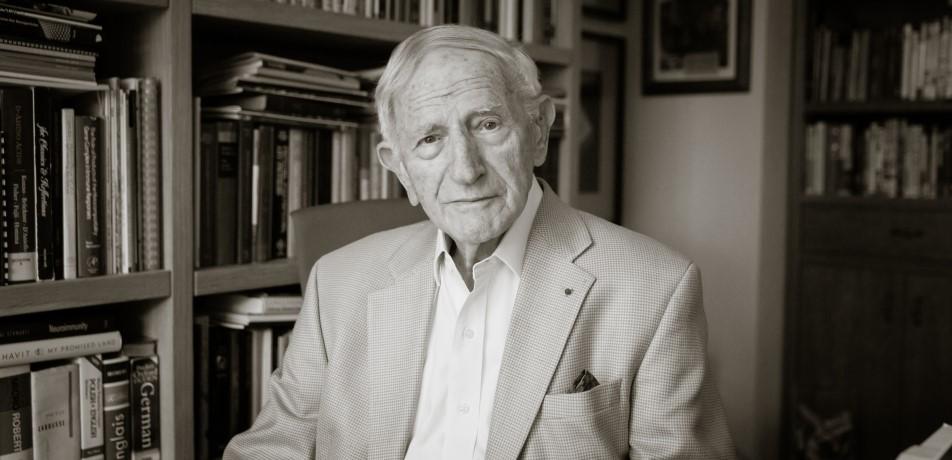
The BSI was saddened to learn about the recent death of Professor Michael Sela.
He was President of the International Union of Immunological Societies (IUIS) from 1977 to 1980, making significant contributions to the field over decades.
Michael Sela, renowned Israeli immunochemist and major figure in international immunology died at the age of 98 on 27 May 2022, just one month after the death of his colleague Professor Hugh McDevitt (28 April 2022). Together they largely founded the field of the genetic control of the immune response with their seminal Journal of Experimental Medicine paper (1965, 122: 517–531) ‘Genetic control of the antibody response. I. Demonstration of determinant-specific differences in response to synthetic polypeptide antigens in two strains of inbred mice’.
Sela was born in Poland in 1924 and named Mieczyslaw Salomonowicz, later changing this to Michael Sela. He grew up in the courtyard of his father’s textile factory but, as antisemitism worsened, the family moved, first to Romania and finally to Palestine – at the time the British administered League of Nations Mandate for Palestine, in 1941. Following a short period of detention, the young Sela worked as a weaver producing gauze for the British military and then the same year entered the Hebrew University in Jerusalem to study chemistry, obtaining his Master’s degree in 1946. Intending to specialise in synthetic polymers and dyes he pursued his doctoral studies in Geneva but, passionate about the formation of the State of Israel, he moved to Italy where he helped European Jews, mostly Holocaust survivors, travel to Israel. Although his immediate family escaped to Israel many of his relatives were killed by the Nazis. When Israel’s independence was declared in 1948, he became a commercial secretary in the Israeli legation in Czechoslovakia. When I first met Michael, in the early 1970s at his international course in immunochemistry for young immunologists at the kibbutz Nof Ginnosar, I could not fail to be enthused by his passion for immunology but also by his delight in showing us around the historic and beautiful features of his adopted country.
In 1950 Sela returned to science, and to Israel, enrolling at the Weizmann Institute for his chemistry PhD with the biophysicist Professor Ephraim Katzir, who was later to become President of Israel. Katzir was a pioneer in synthesising defined polypeptides as a means to discovering the properties of proteins. Sela worked on polytyrosine (a chain of phenols) and poly-p-aminophenylalanine (a chain of anilines) and reasoned that he would be able to produce polypeptidic azo dyes from them. In his reading he encountered the work of Karl Landsteiner on attaching haptens to proteins via an azo bond. Studying Landsteiner’s classic book, The Specificity of Serological Reactions, he learned that gelatin was not antigenic and that this was speculated to be due to the lack of tyrosines. Intrigued, Sela and Ruth Arnon showed that coupling tyrosines to gelatin enhanced immunogenicity without altering specificity. This led to a fascination with what constituted an antigen and the concept that immunogen was different from antigen, and immunogenicity was different from antigenicity. From then on Sela was an immunochemist rather than simply a chemist. Much of what we now know about immunogens stems from the work of Sela and his students.
Synthesising defined polypeptides as antigens, in contrast to whole proteins, Sela was able to dissect the immune response. In work with John Humphrey using Sandylop and Himalayan rabbits, and with Hugh McDevitt on inbred strains of mice, Sela established the existence of immune response genes. Although principally a basic scientist Sela made enormous contributions to human health. Working with Ruth Arnon, Sela was able to prevent the induction of experimental autoimmune disease – experimental allergic encephalomyelitis – by administration of a positively charged polypeptide leading to his development of the revolutionary drug Copoxone for the treatment of multiple sclerosis.
Sela published more than 800 articles, chapters and books. He spoke nine languages, was a strong supporter of the arts in Israel and chaired several artistic organisations. His first wife Margalit Liebman who he married in 1948 died in 1975. The following year he married Sara Kika, who survives him, together with his daughters Irit and Orlee from his first marriage, and Tamar from his second.
An inspiring teacher, a recipient of numerous international awards, Michael Sela was fundamental to the development of modern immunology and immunotherapy.
Frank C Hay
Emeritus Professor of Immunology St George’s, University of London
